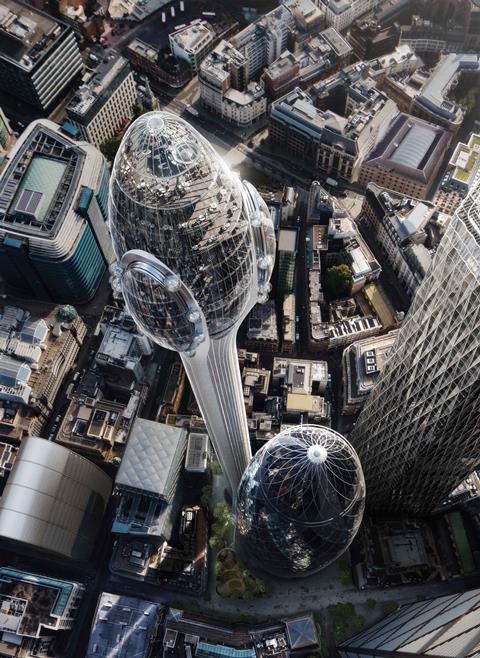Appeal over rejected tower to run until December
The developer behind the City of London’s rejected Tulip tower has urged the government to green-light the controversial Foster & Partners scheme to give the capital a post-covid boost.
Richard Harris QC, representing Luxembourg-based developer Bury Street Properties, suggested that approval for the 305m tall visitor attraction, dubbed the Tulip because of its resemblance to the flower, would give the Square Mile a shot in the arm in the years following the pandemic.

The comments came on the first day of a virtual public inquiry into the scheme following an appeal to the secretary of state Robert Jenrick launched by the developer after London mayor Sadiq Khan rejected the proposal last summer.
The scheme, which would see a 12-storey viewing pod built on top of a concrete ‘stem’, had been approved by the City of London in April 2019.
In his opening remarks, Harris said the tower would “epitomise a new start, a new spring for the City of London - more diverse, more inclusive, more democratic and less mysterious. A city open for business.”
Speaking from inside Foster & Partners’ 2004 Gherkin building, besides which the Tulip would be built, Harris warned that “these are dangerous times” for the City of London, which has lost its world-leading position as a global financial centre to New York in the wake of Brexit.
He added: “The city outside this building is eerily quiet and is getting quieter by the day. We are entering an inevitable economic and social winter.”
He said that the scheme “represents at a difficult time an opportunity to establish in the eyes of the world and those who would invest here the confidence which the government and the planning system has in the City of London as part of a thriving mercantile global city”.
He added that the mixed-use scheme would help to diversify the economy of the Square Mile, bringing ”animation, life and vitality” to the office-dominated district in the evenings and on weekends.
Brushing off concerns the Tulip would harm views of the Stirling Prize-winning Gherkin, he said: “The Gherkin is Fosters’ greatest achievement. They would do nothing to harm its importance or beauty or the strength of its legacy.”
But Hereward Phillpot QC, representing the mayor of London, said the tower and its associated two-storey pavilion – which would be built on the plaza which surrounds the Gherkin – would “harm the ability to appreciate the distinct and singular form of the Gherkin”.
Foster & Partners’ proposals would see the Tulip built just 5m from the base of the existing building, completed in 2004.
Phillpot said: “What is currently uncluttered, relatively generous and activated public space would be reduced to narrow corridors around the two proposed buildings, forming part of what would become a more constrained, complex and less flexible public realm.”
And the proposals came under fire for their impact on views of the nearby Tower of London – one of the principal reasons cited by Khan in his decision to turn it down for planning.
Scott Lyness QC, representing government heritage advisor Historic England, said the proposals are “at their heart asking for permanent and irreversible harm to be caused to significant heritage assets”.
He added: “If these delicate times require a statement, in any language, it should fortify us in cherishing what we have.”
The inquiry is due to sit for 17 days before closing submissions are heard on December 11.
The final call on the tower will then be in the hands of the secretary of state, with no timeframe given for when a decision will be announced.
















No comments yet